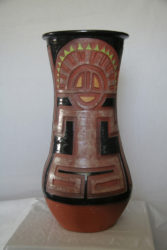In this month’s conversation, artists Stanley Greaves AA and Akima McPherson discuss Trevor Alfred’s pottery piece – Amerindian Hunter, which was completed in 1995. Amerindian Hunter is on show at the top floor of the National Gallery of Art, Castellani House.
Akima McPherson: As a sculptor, I like working with clay because of the ease in manipulating the medium and its versatility. Infrequently, I attempt to use it to make pottery. Pottery is the term applied to vessels (pots) made with clay and typically thrown on a wheel. Ceramic on the other hand could include pots or other objects fashioned from clay or another material, such as silica which changes permanently when heated. So pottery is a subset of ceramic but the two are not synonyms.
Stanley Greaves: You stated that pottery is typically thrown on a wheel, but hand building has a long history. Both techniques have existed together in the past and present. It took me a while to begin working in clay because in 3D, I started working on the reductive principle whereas clay demands the additive… as in constructions and mixed media.

Trevor Alfred
Terracotta and Glaze
1995
(Photo courtesy of the National Gallery of Art, Castellani House)
AM: Indeed hand-building techniques predate the invention and use of the potter’s wheel which has been around since Neolithic times/New Stone age …therefore, millennia. Making the work using a wheel allows the form to be uniform, especially when ‘thrown’ as this work by Alfred seems to be. Not always is the wheel used for ‘throwing’; work can be hand built using a wheel to achieve uniformity. Sometimes to achieve very tall or complex forms, parts are ‘thrown’ on the wheel then joined to each other using slip – a mix of water and clay so the mix has a pasty consistency. The sides to be joined are scoured or scratched arbitrarily and the slip is added moderately and the two ends joined and the seams smoothed out. Working with clay is very technical with numerous factors to be managed.
SG: We have had to comment on ceramic processes because they are not as well-known as paintings. Alfred’s Amerindian Hunter while making use of “Amerindian” imagery of the hunter figure has not created a traditional ceramic form. It means that he is making a personal statement using clay in the way a visual artist will use paints. One suspects that the vessel has more of a decorative function as opposed to utilitarian or daily usage as in tableware. While the hunter theme suggests something thematic it is not in exactly the same way that such a theme might have been explored in paint. Stephanie Correia, our pioneer potter, however, did make the attempt successfully in some of her vessels.
AM: Alfred’s Amerindian Hunter while decorative can still function as a floor vase into which tall objects are placed. After constructing the pot, Alfred would have removed clay to reveal the hunter. Much as a sculptor removes wood to reveal an image, this is how the decoration on this pot was achieved – subtractively. After constructing the pot and carving out the image Alfred would have fired the work in a kiln, doing what is called bisque firing. The resulting form would be hard and durable, and have the orange colour. To achieve the added colour and gloss, glazes are used. Glazes tend to not look as they would when fired so this is a stage of variables. For instance; one can mistakenly apply a wrong colour. After the glazes are applied the work is fired again in the kiln to seal in and ‘release’ the glazes. So while the form is simple along with the decorative elements, Alfred would have had to be very formulaic to achieve this work.





